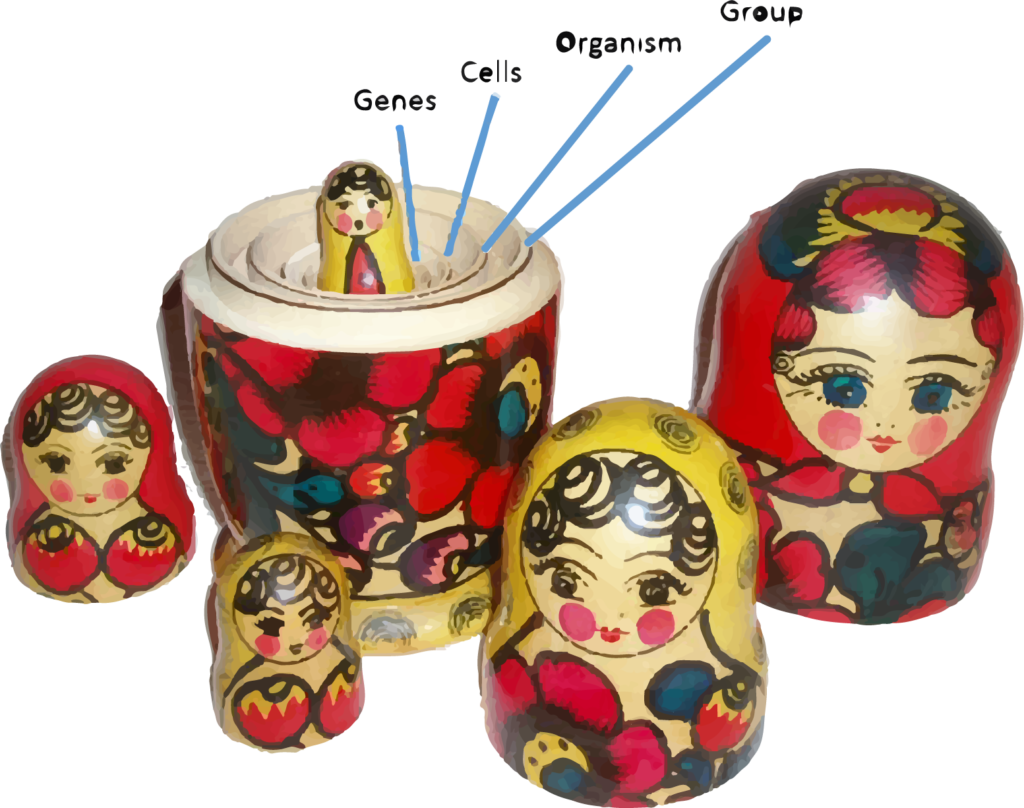
One common criticism against (multi) group-level selection (in favor of kin selection under inclusive fitness framework, which fits the individual selection, plus selfish “genes” narratives better) in explaining the evolution of altruism or other group-oriented traits is that a “group” is ill-defined, organisms seem to come and go and interact ephemerally. However, the concept of “individual” in biology is equally, if not more, ill-defined, as has illustrated in my main essay. Also, the boundary of “inclusive fitness” in kin selection is pretty much the same problem as how to define a group.
Anyhow, this argument (that groups are ill-defined) is a reflection of short-sightedness, when in fact evolution plays out in an unimaginably long time. The basic requirement since the early history of life is that sexually-reproducing organisms of the same species (particularly in the same population) must interact socially relatively more than with groups of other species. Species, albeit sometimes loosely organized spatially, is a somewhat cohere group if you look at it from a long enough timescale (very isolated groups will become new species anyway). If even loosely organized species can be a group, there must be way more tight social groups underneath.
Secondly, early organisms (both sexually and non-sexually reproducing) were less mobile comparatively and tend to concentrate at one location i.e., they must learn to cooperate with those in the closest proximity, which mostly happened to be your immediate parents or siblings i.e., those who did cooperate outcompeted others. (i.e., kin selection, which dwells on some magical “gene eye” that knows to recognize the same gene(s) under layers of “vehicles” is not needed. It is merely a limited phenomenological or statistical conception of this, not necessarily helpful as a causal mechanism. Check this and this for a more complete discussion). These two conditions of early life pass down a legacy effect, sowing the seed of social evolution for eons to come.
If you think about it, that’s the reason why humans historically focus a lot on family, but nowadays when meeting strangers halfway across the world becomes much easier, we immediately seek way more non-kin relationships. That’s how dogs become men’s best friends (at times even sacrifice to save people) without needing to invoke some magical shared genetic relatedness between dogs and humans. That’s why many historical crop breeding successes focus on plot level selection, when individual selection failed to improve yield (cf. Griffing’s work in group selection). And that’s really how highly-coordinated multi-cellular organisms come into being in the first place, etc.
A powerful revelation is that everything can be conceived as a “group”, a community basically consists of multiple reproducing populations (and their physical environment), a population consists of many individuals and their habitat, an individual consists of cells and their bodily environment, a cell consists of replicating chromosomes and their cellular environment, a chromosome consists of many genes/DNA stretches in the chromosomal structural/epigenetic control environment, even a gene is a group of replicating nucleotides. In the often misused case of kin “selection”, you’ll find that it couldn’t be expressed sensibly as the differential survival of kins (unlike other selections comprehended as the differential survival of cells, individuals, groups, etc.), because what really is happening is “kin group” selection. There must be a differential survival of kin social groups at the conceptual level, whether Dawkins and co. like it or not. What is in dispute is just how to express it in a model i.e., Dawkins like to express it in a gene-eye view, just like anything can be expressed at the atomic/subatomic level even with a system of billiard ball collisions. (Just to be sure, I am not a big fan of the common mathematical approach of group selection either, or anything involving the Price equation, for reasons best described here).
In the end, the correct way to view evolution is that: All there is to natural selection is just the selection of certain phenotypes/traits that interact with the environment (different underlying atom arrangements can give rise to similar phenotypes, hence you see biological diversity, convergent evolution). The so-called “unit of selection” embedding a “noun” is indeed somewhat misleading, what matter is the “verb” instead, even myself falls into this bad habit of writing from time to time.

